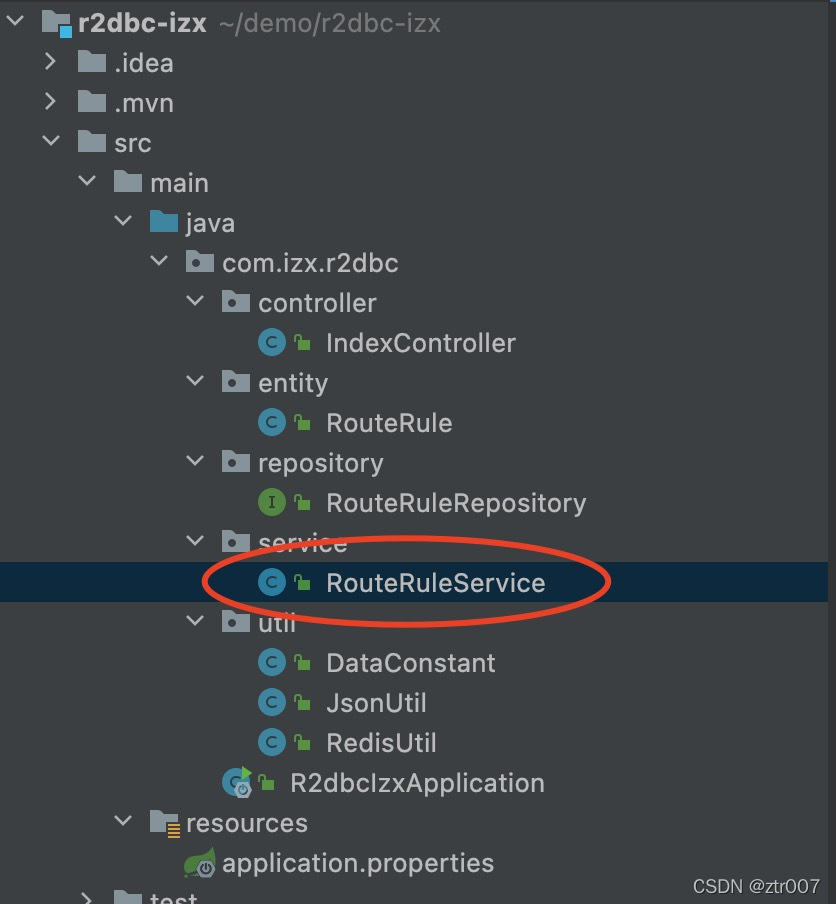Why use reactive processing?
关于SpringBoot WebFlux,Spring官网有如下解释很能说明问题:
One of the main reasons developers move from blocking to non-blocking code is efficiency. Reactive code does more work with fewer resources. Project Reactor and Spring WebFlux let developers take advantage of multi-core, next-generation processors—handling potentially massive numbers of concurrent connections. With reactive processing, you can satisfy more concurrent users with fewer microservice instances.
开发人员从阻塞代码转向非阻塞代码的主要原因之一是效率。 反应式代码用更少的资源做更多的工作。 Project Reactor 和 Spring WebFlux 让开发人员可以利用多核下一代处理器——处理潜在的大量并发连接。 通过反应式处理,您可以用更少的微服务实例满足更多的并发用户。
Reactive系统具有某些特性,使其成为低延迟、高吞吐量工作负载的理想选择。Project Reactor和Spring portfolio协同工作,使开发人员能够构建响应性、弹性、弹性和消息驱动的企业级反应式系统。
Reactive processing反应式处理是一种范例,使开发人员能够构建能够处理背压(流量控制)的非阻塞、异步应用程序。反应式系统更好地利用现代处理器。 此外,在反应式编程中包含背压可确保解耦组件之间具有更好的弹性。
Project Reactor
Project Reactor is a fully non-blocking foundation with back-pressure support included. It’s the foundation of the reactive stack in the Spring ecosystem and is featured in projects such as Spring WebFlux, Spring Data, and Spring Cloud Gateway.
Project Reactor 是一个完全无阻塞的基础,包括背压支持。 它是 Spring 生态系统中响应式堆栈的基础,并在 Spring WebFlux、Spring Data 和 Spring Cloud Gateway 等项目中得到了体现。
Spring WebFlux
The Spring portfolio provides two parallel stacks. One is based on a Servlet API with Spring MVC and Spring Data constructs. The other is a fully reactive stack that takes advantage of Spring WebFlux and Spring Data’s reactive repositories. In both cases, Spring Security has you covered with native support for both stacks.
Spring提供两种并行技术栈,一种是基于Spring MVC 和 Spring Data 结构的 Servlet API,另一种是完全响应式堆栈,它利用了 Spring WebFlux 和 Spring Data 的响应式存储库。在这两种情况下,Spring Security 都为您提供了对两种技术的本地支持。

使用示例
Github地址:GitHub - zuotaorui/spring-webflux-r2dbc
pom.xml
<!-- Spring Boot版本 -->
<parent>
<groupId>org.springframework.boot</groupId>
<artifactId>spring-boot-starter-parent</artifactId>
<version>2.6.6</version>
<relativePath/> <!-- lookup parent from repository -->
</parent>
<dependencies>
<!-- 引入Spring Webflux -->
<dependency>
<groupId>org.springframework.boot</groupId>
<artifactId>spring-boot-starter-webflux</artifactId>
</dependency>
<!-- Reactive反应式数据库驱动 -->
<dependency>
<groupId>org.springframework.boot</groupId>
<artifactId>spring-boot-starter-data-r2dbc</artifactId>
</dependency>
<dependency>
<groupId>dev.miku</groupId>
<artifactId>r2dbc-mysql</artifactId>
</dependency>
<!--HikariCP连接池在R2BC中不可用,连接池选择使用R2DBC Pool-->
<dependency>
<groupId>io.r2dbc</groupId>
<artifactId>r2dbc-pool</artifactId>
</dependency>
<!--Spring Boot 2.0开始内置ReactiveStringRedisTemplate支持反应式高背压Redis访问-->
<dependency>
<groupId>org.springframework.boot</groupId>
<artifactId>spring-boot-starter-data-redis</artifactId>
</dependency>
<dependency>
<groupId>com.fasterxml.jackson.datatype</groupId>
<artifactId>jackson-datatype-jsr310</artifactId>
</dependency>
<!--lombok-->
<dependency>
<groupId>org.projectlombok</groupId>
<artifactId>lombok</artifactId>
<scope>provided</scope>
</dependency>
<dependency>
<groupId>org.springframework.boot</groupId>
<artifactId>spring-boot-starter-test</artifactId>
<scope>test</scope>
</dependency>
</dependencies>Repository
数据访问层通过扩展ReactiveCrudRepository接口,继承Entity在MySQL数据库上执行通用CRUD操作的方法。真香,解放了双手,写最少的代码干最多的事儿...
/**ReactiveCrudRepository注释
*Interface for generic CRUD operations on a repository for a specific type. This *repository follows reactive paradigms and uses Project Reactor types which are *built on top of Reactive Streams.
*针对特定类型的Repository上的通用CRUD操作的接口。
*这个Repository遵循反应式式范例,并使用构建在响应式流之上的Project Reactor类型。
**/
public interface RouteRuleRepository extends ReactiveCrudRepository<RouteRule, Long> {
}
server.port=9010
logging.level.org.springframework.r2dbc=DEBUG
spring.r2dbc.url=r2dbc:mysql://root:123456@localhost:3306/test?serverZoneId=GMT%2B8&sslMode=DISABLED
spring.r2dbc.pool.enabled=true
spring.r2dbc.pool.initial-size=50
spring.r2dbc.pool.max-size=100
#Redis自动化配置类
#SpringBoot2.0之后默认使用的Lettuce客户端连接Redis服务器
#Jedis在实现上是直接连接redis server,如果在多线程环境下是非线程安全的,这个时候只有使用连接池,#为每个Jedis实例增加物理连接
#Lettuce的连接是基于Netty的,连接实例(StatefulRedisConnection)可以在多个线程间并发访问,应
#为StatefulRedisConnection是线程安全的,所以一个连接实例(StatefulRedisConnection)就可以满#足多线程环境下的并发访问,当然这个也是可伸缩的设计,一个连接实例不够的情况也可以按需增加连接实例
#默认情况下连接本地单实例Redis Server是不需要配置的
#生产环境可以通过RedisProperties配置连接哨兵或Cluster集群Redis Server
Service
业务逻辑层通过反应式组件返回Mono或Flux发射器。
Mono和Flux是Project Reactor对Reactive Stream规范中Publisher的实现,Publisher是一个可以提供 0-N 个序列元素的提供者,并根据其订阅者Subscriber的需求推送元素(高背压)。
Reactive Streams is an initiative to provide a standard for asynchronous stream processing with non-blocking back pressure. This encompasses efforts aimed at runtime environments (JVM and JavaScript) as well as network protocols.
Reactive Streams 是一项为具有非阻塞背压的异步流处理提供标准的倡议。 这包括针对运行时环境(JVM 和 JavaScript)以及网络协议的努力。
反应式代码用更少的资源做更多的工作!Reactive Processing更好地利用现代处理器。 此外,在反应式编程中包含背压可确保解耦组件之间具有更好的弹性。
@Service
public class RouteRuleService {
@Autowired
private RouteRuleRepository routeRuleRepository;
@Autowired
private ReactiveStringRedisTemplate reactiveStringRedisTemplate;
public Flux<RouteRule> findAll() {
return routeRuleRepository.findAll();
}
/**根据Id查询Entity
*首先从Redis缓存中查询,如果缓存没有命中则从MySQL中查询
**/
public Mono<RouteRule> findById(Long id) {
return findByIdFromRedis(id)
.switchIfEmpty(findByIdFromDB(id));
}
private Mono<RouteRule> findByIdFromRedis(Long id) {
String redisKey = RedisUtil.getKey(DataConstant.STR_ROUTE_RULE, String.valueOf(id));
return reactiveStringRedisTemplate.opsForValue().get(redisKey)
.switchIfEmpty(Mono.empty())
.transform(mono -> mono.map(val -> JsonUtil.string2Obj(val, RouteRule.class)));
}
/**根据Id从MySQL中查询Entity
*数据库中存在时缓存至Redis 10min 暂不考虑 缓存穿透 和 缓存雪崩
**/
private Mono<RouteRule> findByIdFromDB(Long id) {
String redisKey = RedisUtil.getKey(DataConstant.STR_ROUTE_RULE, String.valueOf(id));
return routeRuleRepository.findById(id)
.switchIfEmpty(Mono.error(new InstanceNotFoundException("route rule not exist")))
.doOnSuccess(routeRule -> reactiveStringRedisTemplate.opsForValue()
.set(redisKey, JsonUtil.obj2String(routeRule), Duration.ofMinutes(10L)).subscribe());
}
}Controller
Mono和Flux发射器,WebFlux的异步非阻塞任务调度器Scheduler,是Reactor的核心,后续会有专题介绍。学习Reactor最好的办法就是查看注释,Reactor的注释真的是业界良心...
@RestController
public class IndexController {
@Autowired
private RouteRuleService routeRuleService;
@GetMapping
public Flux<RouteRule> index() {
return routeRuleService.findAll();
}
@GetMapping("/{id}")
public Mono<RouteRule> get(@PathVariable(name = "id") Long id) {
return routeRuleService.findById(id);
}
}项目结构
























 1587
1587

 被折叠的 条评论
为什么被折叠?
被折叠的 条评论
为什么被折叠?








